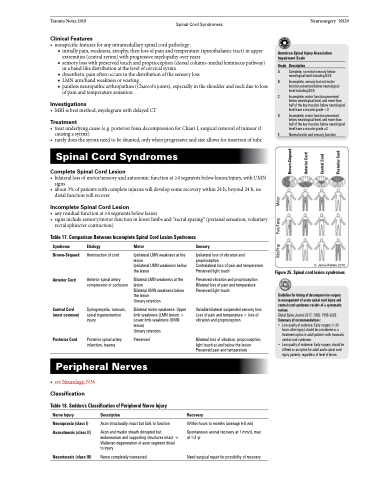Page 827 - TNFlipTest
P. 827
Toronto Notes 2019 Spinal Cord Syndromes
Clinical Features
• nonspecificfeaturesforanyintramedullaryspinalcordpathology:
■ initially pain, weakness, atrophy, then loss of pain and temperature (spinothalamic tract) in upper
extremities (central syrinx) with progressive myelopathy over years
■ sensory loss with preserved touch and proprioception (dorsal column–medial lemniscus pathway)
in a band-like distribution at the level of cervical syrinx
■ dysesthetic pain often occurs in the distribution of the sensory loss
■ LMN arm/hand weakness or wasting
■ painless neuropathic arthropathies (Charcot’s joints), especially in the shoulder and neck due to loss
of pain and temperature sensation
Investigations
• MRIisbestmethod,myelogramwithdelayedCT
Treatment
• treatunderlyingcause(e.g.posteriorfossadecompressionforChiariI,surgicalremovaloftumourif causing a syrinx)
• rarelydoesthesyrinxneedtobeshunted,onlywhenprogressiveandsizeallowsforinsertionoftube
Spinal Cord Syndromes
Complete Spinal Cord Lesion
• bilaterallossofmotor/sensoryandautonomicfunctionat≥4segmentsbelowlesion/injury,withUMN signs
• about3%ofpatientswithcompleteinjurieswilldevelopsomerecoverywithin24h,beyond24h,no distal function will recover
Incomplete Spinal Cord Lesion
• anyresidualfunctionat≥4segmentsbelowlesion
• signsincludesensory/motorfunctioninlowerlimbsand“sacralsparing”(perianalsensation,voluntary
rectal sphincter contraction)
Table 17. Comparison Between Incomplete Spinal Cord Lesion Syndromes
Neurosurgery NS29
American Spinal Injury Association Impairment Scale
Grade Description
A Complete, no motor/sensory below neurological level including S4/5
B Incomplete, sensory but not motor function preserved below neurological level including S4/5
C Incomplete, motor function preserved below neurological level, and more than half of the key muscles below neurological level have a muscle grade <3
D Incomplete, motor function preserved below neurological level, and more than half of the key muscles below neurological level have a muscle grade ≥3
E Normal motor and sensory function
Syndrome
Brown-Séquard
Anterior Cord
Central Cord (most common)
Posterior Cord
Etiology
Hemisection of cord
Anterior spinal artery compression or occlusion
Syringomyelia, tumours, spinal hyperextention injury
Posterior spinal artery infarction, trauma
Motor
Ipsilateral LMN weakness at the lesion
Ipsilateral UMN weakness below the lesion
Bilateral LMN weakness at the lesion
Bilateral UMN weakness below the lesion
Urinary retention
Bilateral motor weakness: Upper limb weakness (LMN lesion) > Lower limb weakness (UMN lesion)
Urinary retention Preserved
Sensory
Ipsilateral loss of vibration and proprioception
Contralateral loss of pain and temperature Preserved light touch
Preserved vibration and proprioception Bilateral loss of pain and temperature Preserved light touch
Variable bilateral suspended sensory loss Loss of pain and temperature > loss of vibration and proprioception
Bilateral loss of vibration, proprioception, light touch at and below the lesion Preserved pain and temperature
Recovery
Within hours to months (average 6-8 wk)
Spontaneous axonal recovery at 1 mm/d, max at 1-2 yr
© Jenna Rebelo 2010
Figure 25. Spinal cord lesion syndromes
Guideline for timing of decompressive surgery in management of acute spinal cord injury and central cord syndrome: results of a systematic review.
Global Spine Journal 2017; 7(3S): 195S-202S.
Summary of recommendations:
• Lowqualityofevidence:Earlysurgery(<24 hours after injury) should be considered as a treatment option in adult patients with traumatic central cord syndrome.
• Low quality of evidence: Early surgery should be offered as an option for adult acute spinal cord injury patients, regardless of level of lesion.
Peripheral Nerves
• seeNeurology,N36
Classification
Table 18. Seddon’s Classification of Peripheral Nerve Injury
Nerve Injury
Neurapraxia (class I) Axonotmesis (class II)
Description
Axon structurally intact but fails to function Axon and myelin sheath disrupted but
endoneurium and supporting structures intact → Wallerian degeneration of axon segment distal to injury
Nerve completely transected
Neurotmesis (class III)
Need surgical repair for possibility of recovery
Vibr/Prop Pain/Temp Motor
Brown-Séquard Anterior Cord Central Cord Posterior Cord


